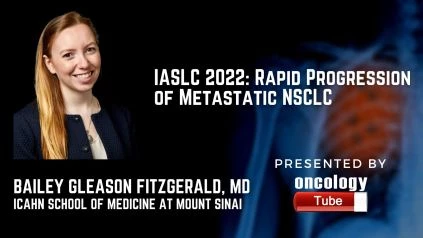Bailey Gleason Fitzgerald, MD, Fellow, Hematology and Medical Oncology, Icahn School of Medicine at Mount Sinai. In this video, she speaks about the IASLC 2022 Abstract Rapid Progression of Metastatic NSCLC treated with First Line Osimertinib: An Institutional Case Series.
Â
Origins:
Â
For patients with EGFR exon 19 or 21 mutant non-small cell lung cancer in the United States, osimertinib is the conventional first-line (1L) tyrosine kinase inhibitor (TKI) (NSCLC). The median PFS in the FLAURA study of 1L osimertinib was 18.9 months. However, the ORR was only 80%, indicating that 1L osimertinib may not be beneficial to a large number of patients. Despite treatment with 2L osimertinib and other EGFR TKIs, dual EGFR and TP53 mutations have a significant unfavorable influence on clinical outcomes. Models have shown primary and acquired osimertinib resistance in TP53 null cell lines in the 1L context, and patients with TP53 mutations and brain metastases had poor CNS disease control with osimertinib. The clinical and molecular characteristics of seven individuals with fast disease progression on 1L osimertinib are described in this case series.
Â
Methodologies:
Â
The patients were treated at the Tisch Cancer Institute at Mount Sinai’s Center for Thoracic Oncology in New York City. Patients with metastatic NSCLC who had a classical activating EGFR mutation in exons 19 or 21 and disease progression within 6 months of initiating osimertinib were included. Tissue-based next-generation sequencing (OncomineTM Comprehensive Assay V3) and/or peripheral blood analysis for circulating tumor DNA (Guardant 360®) were used to confirm the EGFR mutation.
Â
Outcomes:
Â
The median time to progression for the seven patients studied was 92 days (range 21-193). Four individuals had a stable or mixed response at first, but three had illness progression as evaluated by the treating physician. The average age was 69. Asian (5), Hispanic (1), and White patients self-identified (1). Six had never smoked a cigarette in their lives. At the time of presentation, all had lymph node metastases, 5 had bone metastases, and 1 had CNS metastases. Exon 21 L858R mutations were found in five cases, whereas Exon 19 deletions were found in two others. The ECOG performance status of five patients was 0-1. Due to side effects, one patient’s osimertinib dose had to be reduced. Figure 1 depicts the baseline and resistant tumor mutations.
Â
Observations:
Â
To proactively identify individuals who are unlikely to benefit from 1L osimertinib, predictive indicators are crucial. Our findings are consistent with evidence indicating that TP53 mutations are linked to a lower likelihood of benefit from osimertinib, and they imply that this holds true in the 1L scenario as well. Our patients exhibited mixed tumor histology with baseline bone metastases, and three of them had EGFR, KRAS, and BRAF amplifications. A bigger study of genetic and clinical determinants of poor response to 1L osimertinib is now being conducted.

